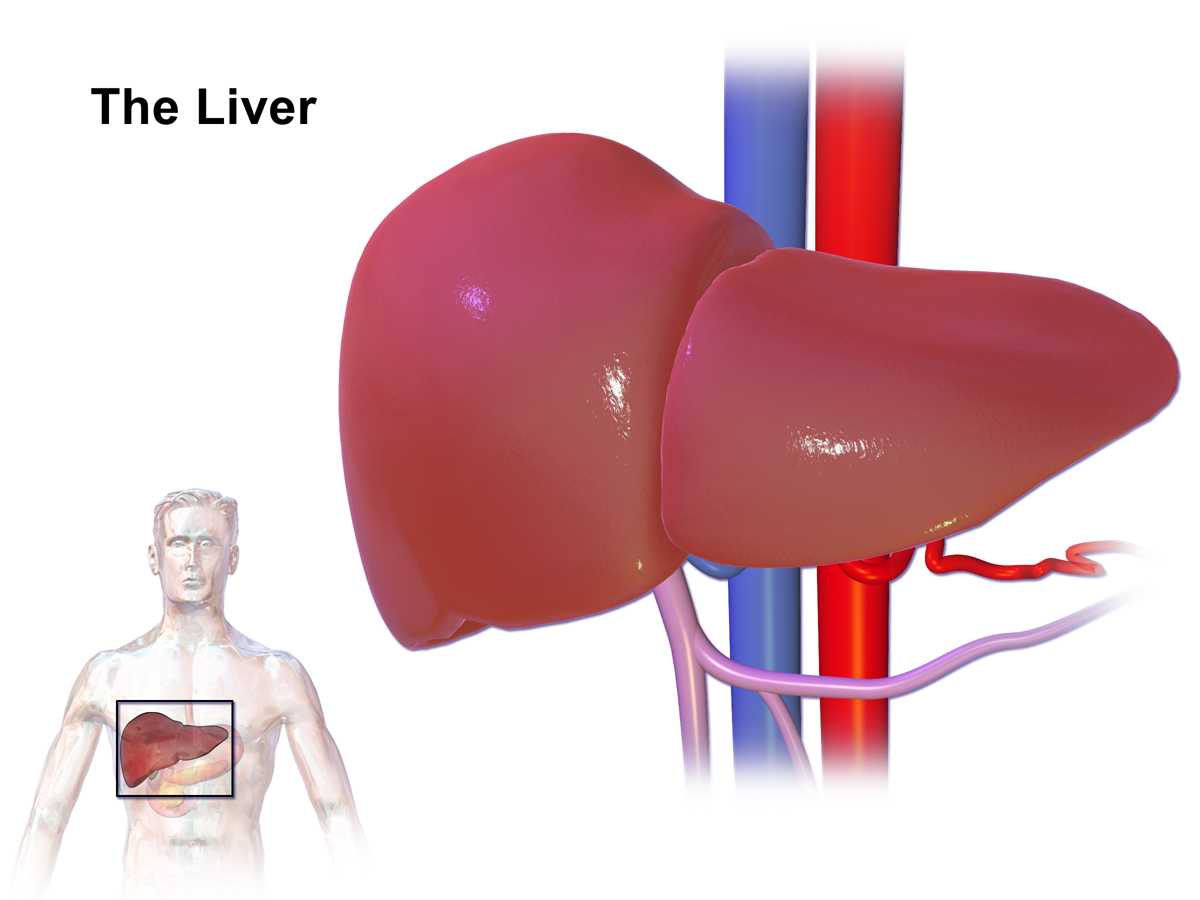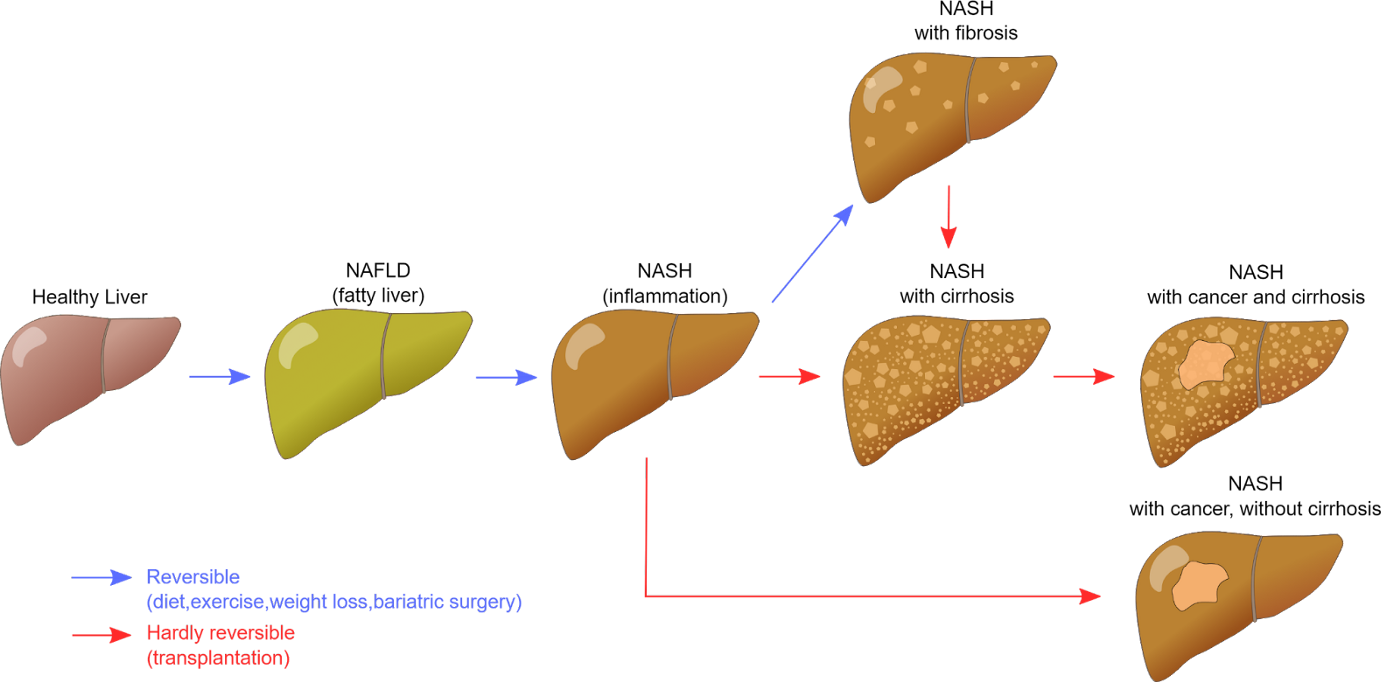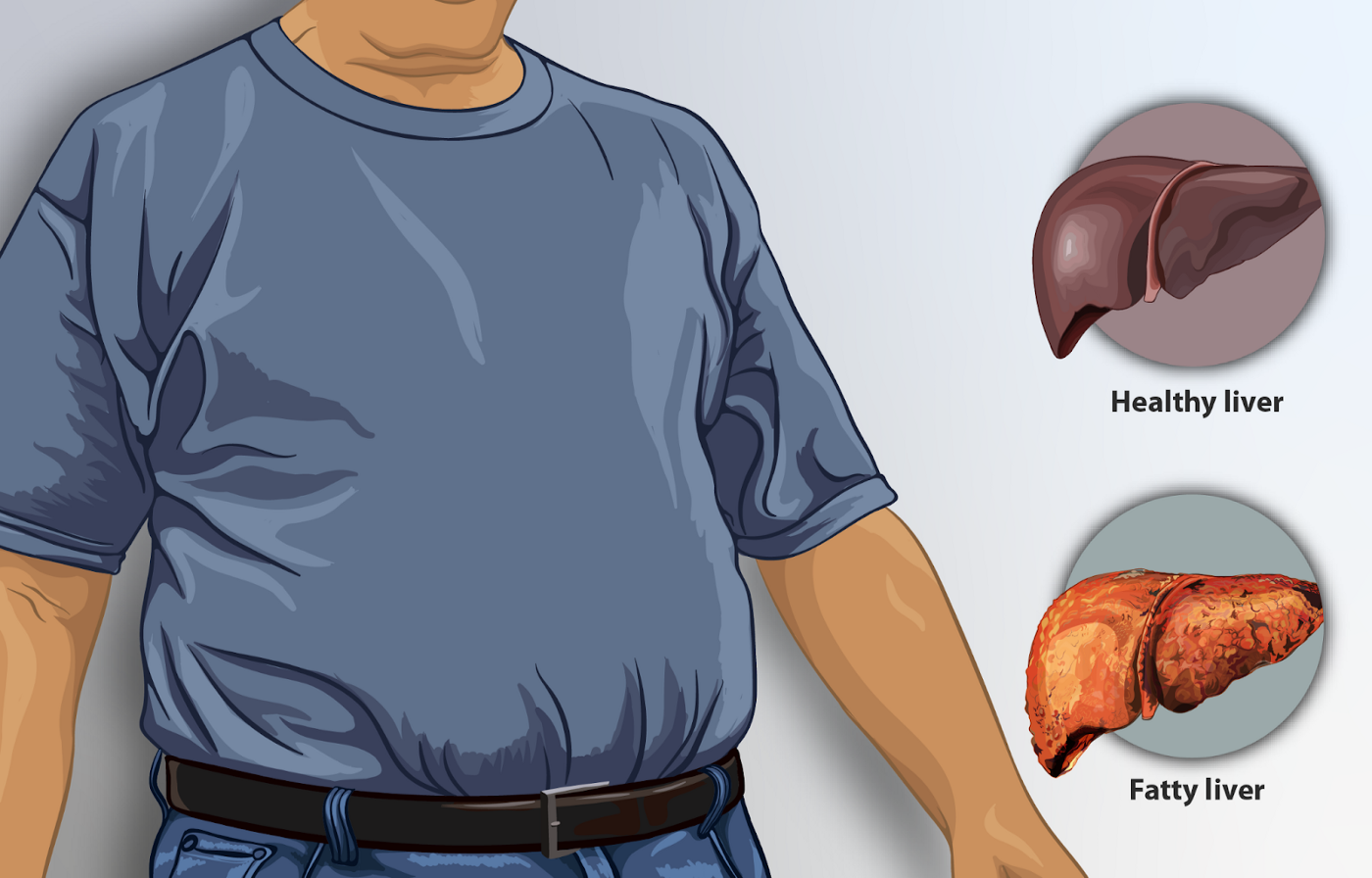When we think or read about the word “fat”, we think about the fat present visibly on our thighs, our abdomens or our arms. Few people are aware of the fat that supports our internal organs or is even present inside our internal organs.
The liver is one such organ that normally has a small store of fat, which can begin to increase and cause serious health conditions, one of which is fatty liver disease.
Out of various liver diseases, fatty liver is a commonly occurring disease. Thanks to our lifestyle and diet in modern days which mostly contain highly processed foods, hydrogenated vegetable oils, sugars etc.
In this blog, we will learn about fatty liver and its different types. We will try to analyse fatty liver disease causes, understand what fatty liver disease symptoms we can notice in such conditions and how it can be diagnosed as early as possible to prevent complications.
Lastly, we will discuss the most relevant topic that is fatty liver disease treatment and dietary tips that need to be followed. Before jumping into the main discussion, let us first take a look at the normal functions of the liver and why it is such an important organ of our body!
What is a liver?
The liver is the largest gland and the second largest organ of the body, located in the right upper abdomen. It performs as many as 300 different vital functions to keep the body pure and out of toxins and harmful substances.
 The liver is the largest gland and the second largest organ of the body.
The liver is the largest gland and the second largest organ of the body.
Without a healthy liver, a person cannot continue to live in a healthy manner since it is an essential organ that supports nearly every function in the body. The different functions of the liver are:
- It produces bile which is necessary for proper digestion and removal of toxic by-products from the body.
- It makes many clotting factors and proteins which are important for every process of healing, repair and growth.
- It is the largest storehouse of many vitamins such as vitamin D, A, K, B12, iron and other minerals. The liver also converts all the B-complex vitamins, nutrients in foods and supplements into their active forms and makes them available for body functions.
- It has huge stores of energy by producing glucose from the different sugars in the diet. It stores glucose in the form of glycogen and converts glycogen to glucose when glucose levels are low.
- It plays a very important role in removing old, worn-out red blood cells from blood circulation.
- The liver eliminates harmful chemicals and waste products after making them harmless via chemical processes.
- It produces proteins for blood plasma, resists infection by removing bacteria from the bloodstream and creating immune factors, regulates blood clotting and the blood levels of amino acids, produces cholesterol and processes haemoglobin.
Advertisements
REPORT THIS AD
Now let us take a look at what it means to have a fatty liver and how to diagnose it!
What is fatty liver disease?
As we know, our body tends to store extra calories in terms of fat in areas of the body to be utilized later as per the need.
The liver cells normally have a small amount of fat (triglycerides), but if too much fat accumulates within the small liver cells, they swell up and occasionally the whole liver is enlarged, which leads to fatty liver disease.
When the level of fat reaches 5–10% of liver weight then it’s considered to be fatty liver. Fatty liver is commonly seen in overweight persons and mostly above the ages of 30.
It is important to know when to reach out to your doctor as the initial stages of the fatty liver don’t show any fatty liver disease symptoms. And you know what? Zyla can help you with this! You can download the Zyla app or visit our website- Zyla.in start your health journey today.
Here are some diagnostic tests that can alert you and your physician to the need for further investigation.
How is fatty liver diagnosed?
At the initial stages, fatty liver disease symptoms are not present and most people are unaware of it. It can be suspected through symptoms or elevated liver enzymes (SGOT/SGPT) in blood tests.
These enzyme levels increase in case of liver inflammation, and to confirm the diagnosis, your doctor may recommend an ultrasound.
Here are some of the tests that are conducted to diagnose fatty liver:
1. LIVER FUNCTION TEST
Unusual levels of liver enzymes in the blood evidently show a proper understanding of the genuine cause of fatty liver. Liver enzymes like SGOT (Serum Glutamic Oxaloacetic Transaminase (SGOT) or AST, SGPT- (Serum Glutamic Pyruvic Transaminase (SGPT) or ALT, Alkaline phosphatase are also checked.
The total protein, the level of serum Albumin and Globulin are also measured. Since these proteins are synthesized by the liver, an abnormal count will denote some liver abnormality.
2. OTHER BLOOD TESTS
High levels of bad cholesterol like cholesterol, triglycerides, LDL cholesterol and VLDL cholesterol can denote dyslipidemia which leads to fatty liver.
Blood tests (serology) are usually used to detect accurately viral hepatitis A, B, C and herpes viruses like EBV or CMV, rubella, and autoimmune-related diseases.
3. ABDOMINAL ULTRASOUND
It is a painless, non-invasive test, which can identify precisely the stage of fatty liver by measuring the size of the liver. This test is also used to grade the stage of improvement.
4. CT SCAN
A non-invasive scan that measures internal organs accurately and in detail with X-rays.
5. TRANSIENT ELASTOGRAPHY
It measures the stiffness of the liver which indicates fibrosis or scarring.
6. MRI SCAN
Another non-invasive technique where radio waves are used in a magnetic field to scan the structures of internal organs.
7. TISSUE EXAMINATION WITH BIOPSY
It is the only widely accepted test to distinguish NASH from other forms of liver disease. This test also provides close observation for useful treatment properly as the liver biopsy confirms the quantity of unwarranted fat in the liver.
With the above information, you might’ve got an idea that fatty liver disease has different types and stages. So let’s start with it’s different types…
What are the different types of fatty liver?
Fatty liver is divided into four types depending on causative factors:
1. ALCOHOLIC FATTY LIVER DISEASE
It is the earliest stage of alcohol-related liver disease with which the liver is damaged by heavy alcohol consumption and is unable to break down fats. In this type, fatty liver disease symptoms may or may not occur.
If you avoid alcohol, the fatty liver will disappear within six weeks of being alcohol-free. However, if excessive alcohol is continuously consumed, complications like cirrhosis may develop.
2. NON-ALCOHOLIC FATTY LIVER DISEASE (NAFLD)
It develops when the liver has difficulty breaking down fats, which causes a build-up in the liver tissue but without inflammation and it is not related to alcohol.
NAFL is diagnosed and confirmed when more than 10% of fat builds up and exists in the liver.
3. NON-ALCOHOLIC STEATOHEPATITIS (NASH)
When sufficient fat builds up, it will cause the liver to swell and inflame. If the authentic cause is not from alcohol, it’s called NASH which can worsen liver function.
If it is left untreated, NASH can move to the advanced stage where the liver will have permanent scarring and ultimately fail to function partly or fully.
4. ACUTE FATTY LIVER OF PREGNANCY
This is a rare problem during pregnancy that can be life-threatening. Symptoms include persistent nausea and vomiting, pain in the abdomen, yellowing of the skin, and depressed mood.
Most women recover after delivery and have no lasting effects but the most common cause is alcoholism.
Once you develop fatty liver disease it can cause irreparable damage to the liver. It may lead to inflammation or scarring of the liver and with further progression, liver failure can occur.
Did you know?
Fatty liver disease can be reversed up until stage II. After that, the changes to the liver are irreversible.
In this blog, we are going to be primarily focusing on Non-Alcoholic Fatty Liver Disease (NAFLD). Let us examine the different stages of a fatty liver!
Stages of Nonalcoholic fatty liver disease (NAFLD)
The stages of NAFLD are divided based on progression. It consists of 4 stages –
 NASH has four different stages.
NASH has four different stages.
1. SIMPLE FATTY LIVER OR STEATOSIS I.E. GRADE I FATTY LIVER
In this stage, excess fat gets stored in the liver cells and minimal inflammation is present but is considered harmless and usually, no fatty liver disease symptoms appear.
The patient may not be aware that he has it until an ultrasound scan test is done. Usually, fatty liver disease is often not identified until a later stage is reached.
If you start a liver-friendly diet and exercise regularly, disease progression can be reversed.
2. NON-ALCOHOLIC STEATOHEPATITIS (NASH) I.E. GRADE II FATTY LIVER
It is a more severe condition as the liver becomes more inflamed and cells in the liver are being damaged where some liver cells even die.
Pain in the top right of the abdomen may be felt at this stage. This stage is also reversible with a liver-friendly diet and regular exercise.
3. FIBROSIS I.E. GRADE III FATTY LIVER
Fibrosis develops when the existence of chronic inflammation in the liver results in the generation of fibrous scar tissue around the liver cells and blood vessels.
This fibrous tissue replaces some of the healthy liver tissues thus reducing the liver’s ability to function properly.
This stage is irreversible, although certain measures can help prevent further progression.
4. CIRRHOSIS I.E. GRADE IV FATTY LIVER
At this stage, a large amount of liver tissue is replaced by fibrotic tissue that doesn’t function as normal liver tissue. The structure and function of the liver are severely affected such that the liver shrinks and becomes swollen, known as cirrhosis.
Although this usually occurs at the age of 50–60 years, it can happen much earlier in some people. Cirrhosis progresses little by little over a period of years, slowly showing fatty liver disease symptoms and then making the liver stop functioning.
The damage caused by cirrhosis can’t be reversed. Advanced cirrhosis is life-threatening.
Now that you have an idea of the various stages of fatty liver, let us look at the various Non-alcoholic fatty liver disease risk factors…
Non-alcoholic fatty liver disease risk factors
Various factors are involved in the generation of NAFLD. We will now discuss these factors or diseases that lead to non-alcoholic fatty liver:
1. HIGH CHOLESTEROL LEVELS
Balanced levels of cholesterol are very important for good health. But when the level of cholesterol increases it starts to build up around the liver and leads to fatty liver.
2. HIGH LEVELS OF FAT ESPECIALLY TRIGLYCERIDES
We know that the liver produces triglycerides but when its level increases drastically it leads to an unhealthy deposition of fat around the liver and produces fatty liver.
3. OBESITY
The generation of NAFLD is firmly linked with obesity. Being overweight/ obese leads to deposition of fat around the liver and further may lead to inflammation or scarring of the liver.
4. TYPE 2 DIABETES MELLITUS
One effect of Type 2 Diabetes mellitus is insulin resistance in which body cells are not able to utilize or absorb glucose, leading to an increase in glucose in the blood. The elevated levels of blood sugar provide material for triglycerides synthesis which further leads to NAFLD.
5. PCOS
In polycystic ovarian syndrome, excess androgens are reported which is linked to insulin resistance which further leads to NAFLD.
For management of weight, diabetes, heart health and PCOS, you can download the Zyla app or visit our website- Zyla.in where you can select the program that suits you and start working on your health through our guidance.
6. PEOPLE WITH CONCENTRATED BODY FAT AROUND THE ABDOMEN
People having uneven distribution of fat over the abdomen due to poor diet habits or lack of physical activity are at risk of developing NAFLD.
7. CERTAIN MEDICATIONS
The use of over-the-counter medication in excess of the recommended doses, such as acetaminophen, can enhance the risk of fatty liver.
It is important to address these risk factors with the right lifestyle measures in order to treat fatty liver disease causes and prevent fatty liver disease symptoms. Talking about fatty liver disease causes, how about we discuss that in a bit of detail?…
Non-alcoholic fatty liver disease causes
There are many factors contributing to the development of fatty liver such as :
- Being overweight or obese, particularly in the abdominal part.
- A poor diet consists of high sugar intake and high fat intake.
- High cholesterol levels and triglycerides in the blood.
- Suffering from metabolic syndrome such as diabetes, hypertension, obesity, dyslipidemia.
- Taking certain medications for over a long period of time.
Now let us look at how fatty liver can present itself…
Non-alcoholic fatty liver disease symptoms
Although for some people they are unclear, the Nonalcoholic fatty liver disease symptoms include:
- Fullness and heaviness in the abdomen, more in the right upper corner
- Nausea and vomiting
- Loss of appetite and weight loss
- Weakness
- Increased liver enzymes (Like SGOT & SGPT)
- Increased spleen size
- Yellowing of skin and eyes (Jaundice)
- Easy bleeds from small wounds and blood don’t clot adequately soon
- High to moderate shivers of the fingers (asteroids)
- Itching in hands and legs
- Veins in the legs, abdomen, get inflamed and swollen
- Poor memory or attentiveness
- Mental confusion is created at the time of emergency (encephalopathy)
- Lack of sexual desire
- Gastrointestinal (GI) bleeding
- Dark colour urine
 Being overweight or obese, particularly in the abdominal part is one of the causes of fatty liver.
Being overweight or obese, particularly in the abdominal part is one of the causes of fatty liver.
If the right action is not taken when these fatty liver disease symptoms appear then complications of this disease can occur which includes…
Non-alcoholic fatty liver disease complications
Cirrhosis is the main complication of NAFLD.
It is the last stage in which scarring in the liver occurs. The liver cells try to fight against inflammation and fibrosis takes place.
The liver does not work as well leading to health conditions like:
- Swelling in the legs and abdomen
- High blood pressure in the veins supplying the liver
- Enlargement of the spleen
- A build-up of toxins that are normally removed by the liver — these toxins can affect the brain.
Did you know?
Around 5–12% of people with NAFLD progress to cirrhosis.
Let us now take a closer look at some of the lifestyle measures one can incorporate in order to manage fatty liver disease symptoms and further treat and prevent NAFLD.
Non-alcoholic fatty liver disease treatment
Since the serious complications of non-alcoholic fatty liver disease are primarily seen in patients with NASH, there are no clear effective treatments for these patients. However, the following lines of treatment have proven to be helpful in such conditions:
1. WEIGHT LOSS AND EXERCISE
These are the most trustworthy treatments for non-alcoholic fatty liver disease. Less than 10% decrease in weight may be enough to set right the existing condition of the disease.
Vigorous exercise reduces liver fat as well as reduces the inflammation of NASH.
2. INSULIN SENSITIZERS
Metformin (Glucophage) is a drug used for treating diabetes that enhances the insulin sensitivity of cells, duly preventing the insulin resistance that accompanies the non-alcoholic fatty liver disease and metabolic syndrome.
3. PIOGLITAZONE AND ROSIGLITAZONE
These drugs are also utilised for treating diabetes since they increase insulin sensitivity. There has been a reduction in liver fat and symptoms of liver injury.
4. ANTIOXIDANTS
Vitamin E has been studied in NASH because of its general effects against inflammation. It has been shown to reduce liver fat and inflammation and the possible occurrence of fibrosis.
5. OMEGA-3-FATTY ACIDS
Short studies have shown some benefits with omega-3-fatty acids in reducing liver fat in non-alcoholic fatty liver disease. It can also reduce cardiovascular events such as heart attacks and overall mortality.
Thus omega-3-fatty acids may be an appropriate treatment for patients with non-alcoholic fatty liver disease and metabolic syndrome as these patients are prone to cardiovascular disease and other health issues.
6. LIPID-LOWERING DRUGS
Lipid-lowering drugs, specifically statins and ezetimibe (Zetia), have been used to treat the abnormal rise of blood lipids associated with metabolic syndrome and thus, reducing the impact on liver.
7. BARIATRIC SURGERY
It is a surgery of the gastrointestinal tract which can help in weight loss.
Since obesity is believed to be an important factor in non-alcoholic fatty liver disease and loss of weight has been shown to have beneficial effects on this disease, bariatric surgery has been considered as a potential treatment for the last stages of non-alcoholic fatty liver disease.
8. LIVER TRANSPLANTATION
Once a liver has become cirrhotic and if the developed complications cannot be controlled or when the liver ceases functioning, liver transplantation is essential by replacing the diseased liver with a transplanted liver.
How to prevent Non-alcoholic fatty liver disease?
1. PICK UP A HEALTHY (FATTY LIVER) DIET
Moving to a liver healthy diet, can prevent fatty liver disease symptoms to occur and thus the development of NAFLD as well as prevent its progression to a higher grade.
2. MAINTAIN WEIGHT
Being overweight/ obese is also a leading factor for fatty liver. Once you start controlling your body weight, you will also notice a change in your health and prevent the progression of fatty liver.
3. EXERCISE ON A REGULAR BASIS
Doing exercise on a regular basis will help you reduce your body weight which is a causative factor for NAFLD. By doing exercise, you will reduce your weight and also improve your cholesterol levels.
4. CONTROL BLOOD SUGAR LEVELS
As we know, high blood sugar levels occur when our body cells are not able to utilize or absorb glucose and it remains in the bloodstream. Glucose provides starting material for triglyceride synthesis which is a leading factor of NAFLD development.
5. CONTROL CHOLESTEROL LEVELS
Our body contains good cholesterol along with bad cholesterol. Balanced levels of cholesterol are very important for good health. These are synthesized by our liver.
Once these levels increase they start accumulating in the liver and develop fatty liver. You can control your cholesterol level by improving physical activity, having omega-rich food products and also by avoiding fried food.
6. KEEP A CHECK ON YOUR LIVER
Get your Liver Function Tests (LFT) and Ultrasound (USG) done as advised by your doctor. Look out for fatty liver disease symptoms. Get vaccinated for Hepatitis A and B to prevent future attacks of these viruses.
7. USE OF VITAMIN E
Its antioxidant property helps in reducing inflammation of the liver and also neutralizes liver damage caused by fat. By preventing inflammation of the liver you can also prevent the conversion of one grade of fatty liver to another grade.
8. AVOID SMOKING AND ALCOHOL CONSUMPTION
You already know that smoking and alcohol are not good only for the liver but for other organs as well. It is better to stay away from these so that your liver can repair itself.
9. AVOID SELF-MEDICATION
Avoid usage of over-the-counter medicines. Check with your doctor before starting any medicines like antibiotics or pain killers and always avoid self-medication.
The above treatments and preventions indicate the importance of diet so let us take a look at some dietary measures that can help us reduce the accumulation of fat in the liver…
 Improving diet has proven improvement in fatty liver.
Improving diet has proven improvement in fatty liver.
Non-alcoholic fatty liver disease diet
If you have fatty liver disease, your doctor or nutritionist might motivate you to modify your diet to a fatty liver diet to prevent disease progression or subside related symptoms. it will also help in further fatty liver-related complications.
Here are a few dietary recommendations:
- Diet rich in plant-based foods: It includes dry fruits, vegetables, fruits, legumes, and whole grains. These inclusions are good for liver health because they are rich in fibre, protein, vitamins and minerals.
- Limited consumption of processed/ refined carbohydrates: This includes sweets, white rice, refined flour and other refined grain products. Limiting the above can help prevent insulin spikes and the resulting deposition of fat in the liver.
- Avoid the consumption of trans fats: which are found in many processed snack foods as they can increase your cholesterol, blood sugar levels and body weight.
While a fatty liver can indicate future serious health concerns, it is possible to reverse the early stages of fatty liver by looking after fatty liver disease symptoms. It is important to incorporate these dietary changes and lifestyle measures in order to live a healthy disease-free life.
We encourage you to reach out to a doctor, in case of any concerns related to your liver health. Early action and lifestyle changes can help prevent serious liver-related health concerns later on in life.
In case you’re looking for personalised guidance and treatment for your liver health, Zyla can help you. At Zyla, we focus on your medical history, lifestyle, food preferences etc to provide you with customised care.
You can download the Zyla app or visit our website- Zyla.in to enrol in our Liver Lifeline Program and start your health journey today.
Stay healthy!
Connect with us:
- Subscribe to our Youtube channel: https://bit.ly/2o19OzE to watch videos on health and health-related conditions.
- Find us on Facebook: https://www.facebook.com/zylahealth
- Find us on Instagram: https://www.instagram.com/zylahealth/
- Visit our website: https://www.zyla.in/
- Talk to us on WhatsApp — https://goo.gl/kjofP
For more information, visit website
https://blog.zyla.in/fatty-liver-disease-symptoms-causes-and-treatment-zyla-health-26452f732467




Comments